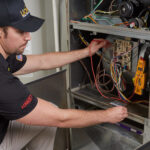NAWT – OnSite Treatment Tank Pumping and Cleaning Code of Practice
SAFETY
At all times, the service expert’s personal safety, as well as protection of the environment and the customer’s property, shall receive the highest priority. Generally, the tanks should not be entered as they are a hazardous environment. If entry is required, appropriate confined space entry procedures consistent with OSHA requirements should be employed.
ACCESSING TANKS
Tanks shall ONLY be pumped from/through the manhole/access port of each tank or tank compartment. Tanks shall NOT be pumped from/through the observation port. If the customer insists upon the tank being cleaned through any opening other than the access manhole, the customer shall be required to sign a waiver acknowledging the fact that he has been informed of the proper procedure and the reasons associated with that procedure. No liquids or solids are to be discharged into/through the outlet pipe.
TANK CLEANING
The liquid, solid, and semi-solid material in a treatment tank is removed by a vacuum or centrifugal pump fitted with a hose which delivers the material to a truck-mounted, sealed tank. Cleaning procedures should include agitating all solids, but only after lowering the liquid level to 12 inches below the outlet. This is necessary to insure no solids are allowed to escape the treatment tank. Agitation methods vary, and may include alternate pumping and back flushing, forcing air into the tank, or mechanical stirring. When back flushing or injecting air, care shall be taken NOT to fill/refill the tank to a level greater than 12” below the elevation of the outlet pipe. Tanks shall be deemed to be clean when all organic solids are removed and the total average liquid depth remaining in the tank is between 1” and 3”. When using equipment that is specifically designed and operated to remove the material from the treatment tank, separate the solids and the liquids, and return the liquids to the tank, the following additional conditions must be met. The liquid discharged to the treatment tank must have a TSS (Total Suspended Solids) of 400 ppm or less, and the volume of returned liquid must be less than the volume of the treatment tank (measured to the invert of the overflow pipe) so as not to have liquid overflow into the absorption area.
STANDARD SERVICES
Every pump-out shall include a visual inspection of the interior of the tank. The inspection shall include a determination regarding the presence of baffles and their condition as well as the physical condition of the treatment tank. Observations of any unusual conditions such as high or low liquid level, run-back from the absorption area, defective or broken components, missing or broken observation port(s), lush vegetation, and/or sewage overflows should be reported to the customer. During system maintenance it is advisable to observe sewage flows from the building into the tank. Corrective action for obstructions should be recommended. Any unsatisfactory conditions should be noted on the sales slip or receipt. Future maintenance frequency should be communicated to the customer at the time of service.
ADDITIVES
NAWT has no position on the use of chemical or bacterial additives for treatment tanks as the research on this is inconclusive.
LOCAL, STATE, AND FEDERAL LAWS AND REGULATIONS
At all times, and in all phases of operations, pumper businesses and equipment operators shall comply with all laws and regulations regarding the activities associated with onsite wastewater system maintenance and disposal of materials removed therefrom.
REPORTS
Where the municipality requires documentation of pump-out and tank and site conditions, the pumper shall not be prevented by the customer from complying with municipal requirements. A copy of the report sent to the municipality shall also be provided to the customer.
RESPONSIBILITY
While NAWT has adopted this Code of Practice as a recommended standard it accepts no responsibility for the actions of any individual with regard to this standard. It is the responsibility of the contractor to give ethical and professional services to its customers and the responsibility of the customer to assure quality control.

















